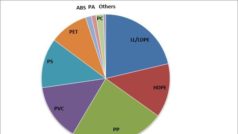More than 40countries worldwide have adopted protectionist measures to limit or halt scrap exports – including some European nations. For example, Spain’s Waste Act of 2012 allows retailers and banks among others to demand that their waste be recycled within Europe. Only around 12% of the total plastics waste generated within the EU is actually recycled inside its borders while some 38% is still going to landfill because the region “does not have enough capacity to recycle it”, he said. “If there are any restrictions whatsoever, prices will collapse and collection of scrap will go down.” This would defeat the EU’s goal of creating a resource efficient economy, Mr Borad argued.
In his report on the Indian market, the same speaker suggested the recent election of a pro-business government could lead to an increase in the number of companies granted plastics scrap import licences. Meanwhile, and despite suggestions that the Green Fence initiative has come to an end, the President of the China Scrap Plastic Association – Dr Steve Wong – contended that his country’s commitment to preventing imports of contaminated material will surely endure. He also indicated that import tariffs of 6.5% and VAT of 17% have weakened China’s competitiveness in terms of recyclable plastics procurement. Rising labour costs have also dented China’s overall ability to compete.
On a similar theme, Gregory Cardot of Veolia said that customs controls have also been intensified in Europe.
Cultural differences have influenced the recycling rates achieved in different countries around the world, argued Tamsin Ettefagh, Vice President of Sales and Purchasing at North America’s second-largest HDPE recycler Envision Plastics. Fellow guest speaker James Glauser, Senior Consultant at US-based information business IHS, underlined the same point by calculating that recycling rates for all PET consumed vary from less than 20% in some parts of the world to a high of around 40% in Central and South America.
Maite Quinn, who is responsible for business development and marketing of plastics, paper and glass at Sims Municipal Recycling in the USA, attributed a recycling rate of just 16% in New York to a variety of factors, including communication issues because of the 170 different languages spoken in the city as well as a high turnover of residents.
A subsequent “Leading Expert Talk” on the future of plastics recycling featured brief presentations from: Dr Steve Wong; Bill Carteaux, President of the US-based plastics industry trade association SPI; Dawn Gaines, Sales Manager of Rock-Tenn, one of North America’s leading producers of corrugated and consumer packaging and recycling solutions; John Standish, Technical Director of the North American Association of Postconsumer Plastics Recyclers; and Hamilton Wen, Director of the Plastic Division at US broker Newport CH International, LLC.
While plastics “will have a continued role in modern society”, said Mr Carteaux, the industry must address the perceived lack of recyclability of plastic products and also the lack of post-consumer supply to meet demand. Key challenges in China, according to Dr Wong, include the combination of lower volumes of plastics scrap available and a significant number of new entrants into the sector.
According to Mr Wen, the Green Fence initiative in China has led to a sizeable shift in scrap flows to other destinations. “China really was the place to go but we’re seeing that change now,” he said. “Green Fence has really given these other markets a chance to develop.”






